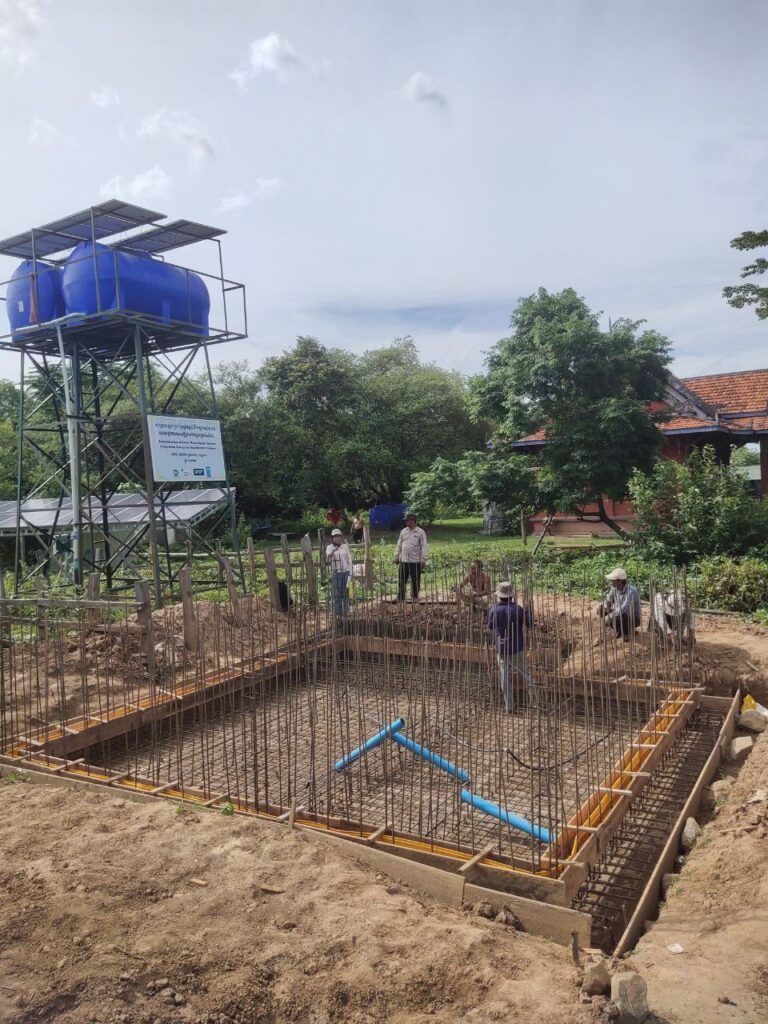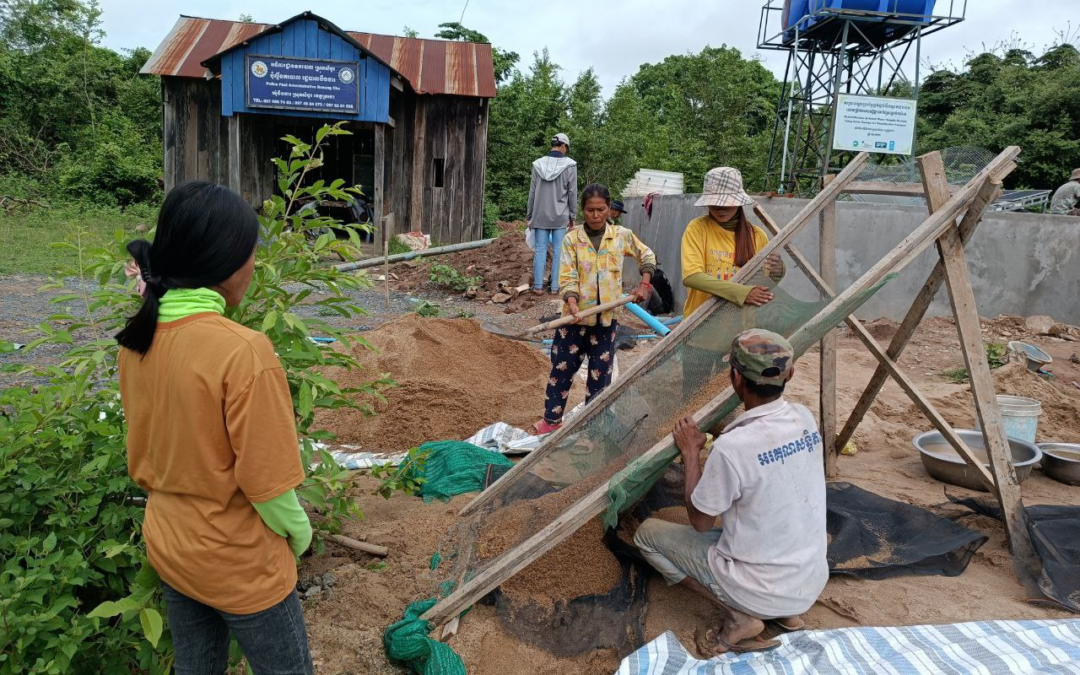As the Mekong River ambles south from its origin in the Sanjianyuan nature reserve in China, it passes through Myanmar, Laos, and Thailand before arriving in Cambodia where it fractures into winding ribbons that create islands in the flow.
The people of Koh Tnoat live on one of the Mekong’s many riverine islands and rely on water from the river for drinking, washing, cooking, and watering their gardens and livestock. But water from the river, having travelled far through dams and areas of heavy agriculture, often isn’t safe to use, let alone drink.
The challenge of delivering clean water to Koh Tnoat is a complicated engineering problem but one that Cambodian engineer and EWB Engineering Technology Project Lead Mariny Chheang wanted to tackle nonetheless. Mariny studied Environmental Engineering at Chulalongkorn University in Thailand and finished her bachelor’s degree in Water Resources Engineering and Rural Infrastructures at ITC in Cambodia. While studying, Mariny visited remote communities and was shocked by what she found.
“I went to […] the community on the river, the floating village, and I saw they drink the same water [as they use for washing] and the water looked like coffee,” she said. “And it made me feel like I have to work on this [for] my country”.

Mariny in Koh Tnoat for construction of the water treatment plant.
The Koh Tnoat water problem
The town of Koh Tnoat needed clean water and until now, no one had been able to crack this problem. For centuries, water was collected and brought home where it was stored in large concrete jars for several hours. This is an ancient technique used to clarify water as it allows the sediment to settle and clear water can be skimmed off the top. But river water today is different. It’s more polluted from agricultural runoff and chemicals and during monsoon season, it’s incredibly turbid.
In 2017, a local NGO called the Cambodian Rural Development Team (CRDT) installed a water distribution system for agriculture and irrigation. The system was designed to transport water from the Mekong into a central water tower through 3,000 metres of piping to around 60 houses using solar power. The problem? Buffalo are heavy. The pipes weren’t buried deep enough and weren’t robust enough to stand up to the soil impaction created by the buffalo on the island. The pipes cracked and the water pressure became unreliable. People reverted to the old ways of collecting water.
Community consultations
The CRDT team reached out to EWB in 2019 hoping that, together, they could fix the water problem in Koh Tnoat. When Mariny and the EWB team arrived in Koh Tnoat, they spoke to the community about what was needed. They expected to learn the community wanted water primarily for agricultural use but a different story emerged during the community consultations. The people of Koh Tnoat wanted clean water, pumped into their homes, for everyday use.
”We found that they use [untreated water] for drinking, cooking, and home consumption. Everyone said ‘We need clean water’. They live on [an] island, they have a lot of water around them, but it’s not that easy to access,” Mariny said.

Consultation with the Koh Tnoat community in November 2022.
Clean water would change the lives of the Koh Tnoat community, particularly the women as the task of collecting water falls to them. Each morning, women make their way to the river’s edge with two 20-litre buckets attached to bamboo support poles. It’s not an easy chore as the edge of the river is steep, especially in the dry season when the water levels drop low and squelchy mud lines the bank. Even women who’ve just given birth are expected to make the trip to the river to collect water. Mariny and the team committed to providing clean water directly to 60 households, a community farm, a commune, and a primary school.
Finding a solution
Although the onset of COVID-19 and travel restrictions slowed the work, the EWB team prototyped and tested solutions from 2021. To stand up to the weight of the buffalo, the PVC piping would need to be swapped out for high-density polyethylene (HDPE) instead. The system would need to be powered by solar as Koh Tnoat isn’t hooked up to the grid.
The previous solution installed solar power panels but the system didn’t have enough capacity to pump water through the three kilometres of pipes needed to reach every household. In 2022, the Cambodian team retrofitted the existing solar system to increase capacity, allowing the system to pump water all day. Once the distribution system was completed in April 2022, Mariny and her team got to work designing a water filtration system to fit the existing infrastructure.
During this time, we engaged our pro bono technical partner, Aurecon, to support the design of a water treatment plant. They jumped on board and shared their technical expertise, overseeing the design of a filtration prototype. After years of collaboration and prototype testing, Mariny designed a solution inspired by those same traditional water purification techniques that served the community for millennia.
Sand filtration
Sand filtration is a filtration method that uses sand from the Mekong to filter out algae and particles of sediment from the water. Raw water from the Mekong is pre-treated in a coagulation in-flow tank, mixing with poly-aluminium chloride (PAC) to encourage sediment to form clumps (floc) and, eventually, be filtered out. From here, the water flows into the flocculation tank and a system of baffles is used to slow the flow and allow the particles time to collide, bind, and settle. The water then runs into the sand filter.

Construction of the base of the water treatment plant in Koh Tnoat.
The sand used in the filter must have a diameter of between 1 and 1.5 millimetres to effectively filter the water. If the sand is too coarse, it won’t filter particles as well and if the sand is too fine, it won’t allow the water to flow through fast enough. Mariny and her team have worked with the community to find and test the right type of sand to allow the filter to work optimally, sourcing the sand from the banks of the Mekong itself. The water that emerges from the filtration system isn’t strictly drinkable – like most places in Cambodia, people are still encouraged to boil the water to kill any remaining bacteria before drinking but it’s clean enough for washing, cooking, and agriculture.
The sand filtration and distribution system will be maintained by a supported local water operator from the community, giving control and independence over their water supply to the people of Koh Tnoat.
The bottom line
The team is on track to complete the Koh Tnout project by December 2023. The total material cost of providing clean water to an entire community comes in at just under $70,000 Australian dollars. Koh Tnoat’s solar-powered water filtration system will become the blueprint for providing clean water to remote communities in Cambodia and beyond.
Fund this work and other projects like it – make a donation today and make a difference for communities like the Koh Tnoat community.
This project received technical support from EWB pro bono partner, Aurecon. EWB Australia’s work in Cambodia receives support from the Australian Government through the Australian NGO Cooperation Program (ANCP).


